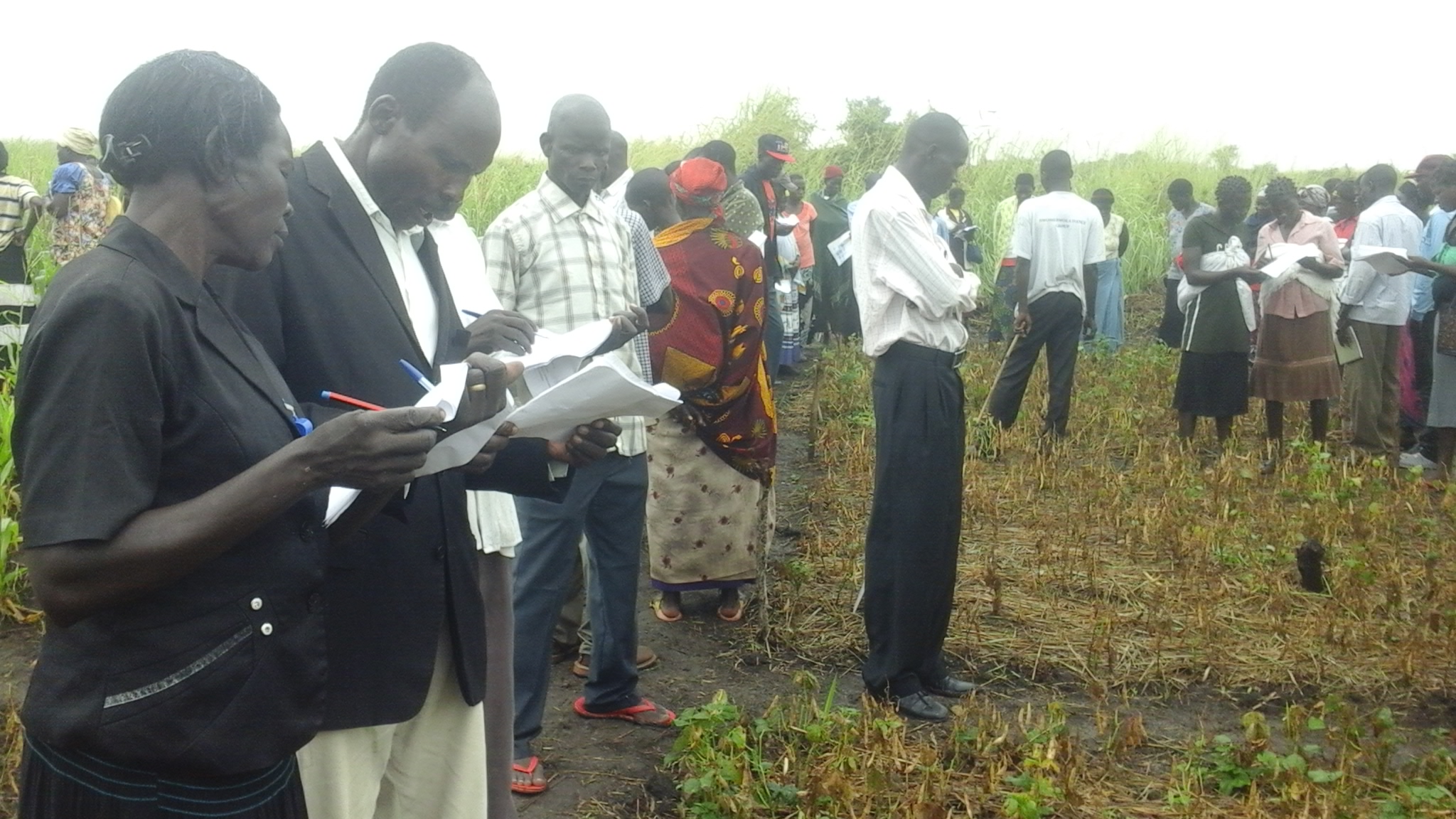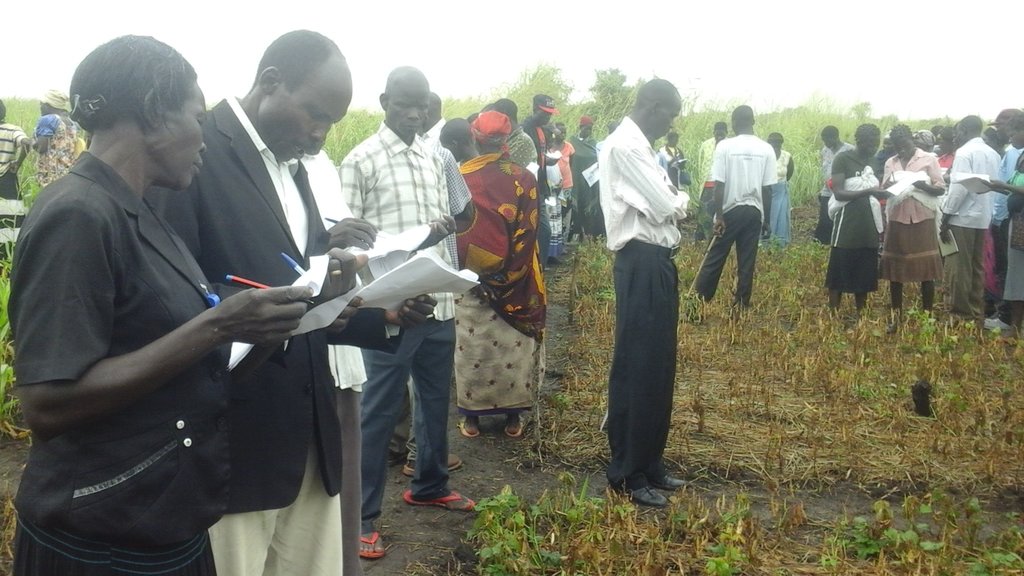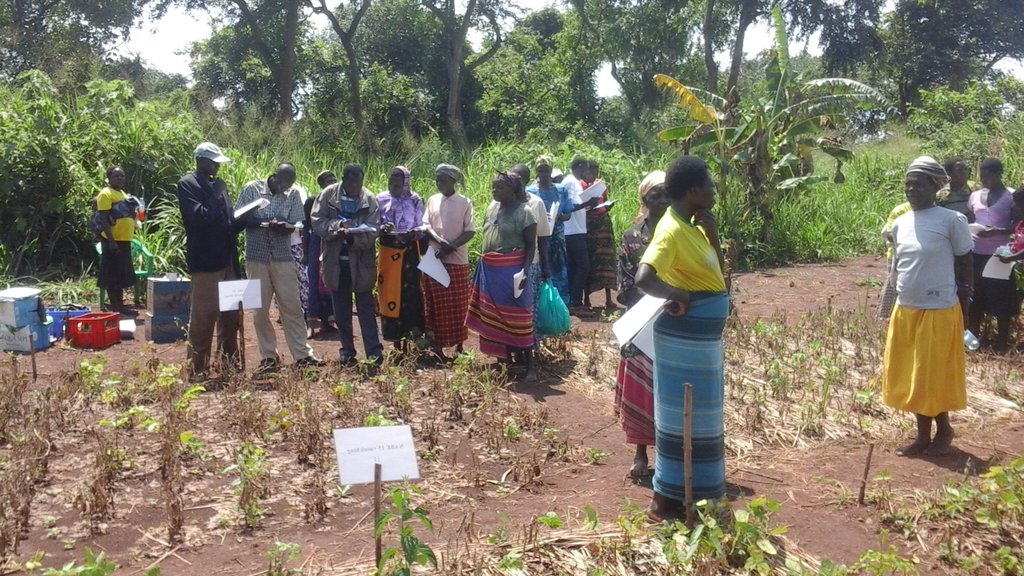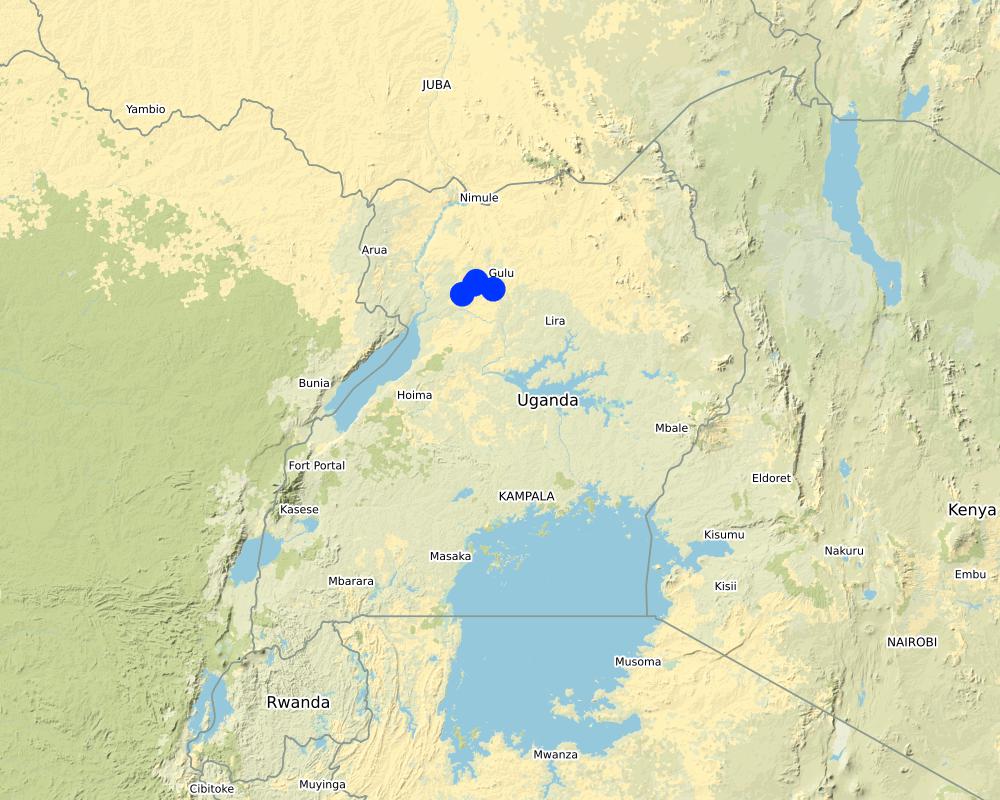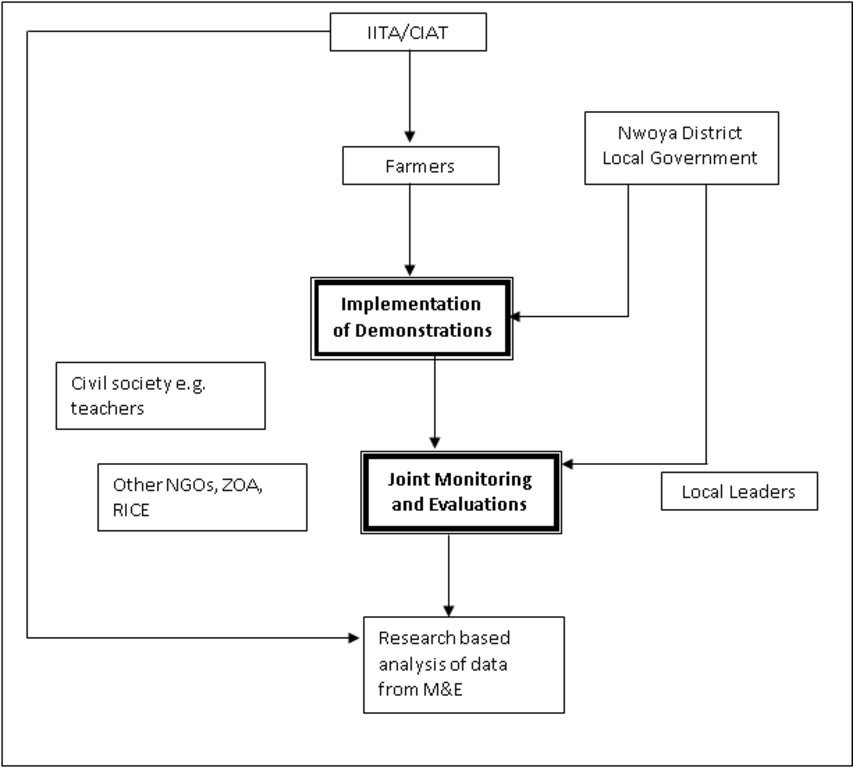Participatory Monitoring and Evaluation of Demonstration Plots [Uganda]
- Creación:
- Actualización:
- Compilador: Sunday Balla Amale
- Editor: JOY TUKAHIRWA
- Revisor: Udo Höggel
Lwak kamoko ber pa diro
approaches_3370 - Uganda
Visualizar secciones
Expandir todo Colapsar todos1. Información general
1.2 Detalles de contacto de las personas de referencia e instituciones involucradas en la evaluación y la documentación del Enfoque
Nombre del proyecto que facilitó la documentación/ evaluación del Enfoque (si fuera relevante)
Scaling-up SLM practices by smallholder farmers (IFAD)Nombre de la(s) institución(es) que facilitaron la documentación/ evaluación del Enfoque si fuera relevante)
Makerere University (Makerere University) - Uganda1.3 Condiciones referidas al uso de datos documentados mediante WOCAT
¿Cuándo se compilaron los datos (en el campo)?
14/11/2017
El compilador y la/s persona(s) de referencia claves aceptan las condiciones acerca del uso de los datos documentados mediante WOCAT :
Sí
2. Descripción del Enfoque MST
2.1 Breve descripción del Enfoque
In Participatory Monitoring and Evaluation of demonstrations, all the players or stakeholders involved in the implementation of the demonstration come together to carry out a joint monitoring and evaluation of the performance of the technology being implemented.
2.2 Descripción detallada del Enfoque MST
Descripción detallada del Enfoque MST:
Demonstration plots established to train farmers are common channels through which recommended farming practice(s) are demonstrated to local farmers. During this process, all the relevant stakeholders in the agricultural sector, for example farmers, local leaders and government extension officers, partner organisations, and the lead implementing agency plan together on how best to implement the demonstration with emphasis on the host community, their roles and responsibilities so as to ensure successful implementation of the demonstration.
Stakeholders involved include:
•Group and community members (women, youth and men)
•Local leaders and authorities
•Civil servants
•Partner Non-Governmental Organisations (NGOs)
•Lead implementing agencies (International Institute of Tropical Agriculture, IITA and International Center for Tropical Agriculture, CIAT)
For the subsequent monitoring and evaluation (M&E) process, the participating stakeholders are invited for a field day on the site of the demonstration. Such M&E process is performed twice or three times during implementation of the demonstration activities depending on necessity, availability of time and resources. The M&E tool is designed by the M&E officer in the organization (IITA/CIAT) supported by the Field Officer/Research Assistant who is responsible for carrying out the field activities. The emphasis of the M&E process is on the goals and objectives, sustainability and adaptive nature, socio-economic and political environment, gender and policy considerations and impacts of the project being implemented. Group members help identifying the stakeholders in their community who can be resourceful in evaluating the demonstrations.
The Participatory Monitoring and Evaluation (PM&E) of the demonstration process, activities and performance is then carried out. It aims to:
•Assess the technology/practice(s) in question in terms of crop vigour and yield
•Understand the resilience of the practice to local prevailing climatic and weather conditions
•Assess whether equal opportunity was given for all community members to participate
•Assess the level of cooperation among group members during meetings
•Understand the gender perspectives with regard to gender equality, woman and youth involvement
•Test for the benefits, performance, pros and cons, and the opportunity cost involved in adopting a demonstrated technology
The PM&E questionnaire is based on IITA/CIAT PM&E tool and is composed of the following chapters:
1.Socio-demographic characteristics: district, sub-county, village, name, telephone contact, age, sex, educational level, employment and group-membership of the participant.
2.Farming characteristics: years of farming experience, total amount of land owned and allocated for farming or particular technology of interest, type of seed (local or improved) and the variety of the crop in question, source of seed and whether or not the participant participated in implementing the demonstration.
3.Implementation performance: Demo-plot location, distance, farmer trainings, demo-management, partnerships in the implementation, participation, cooperation, importance, relevance, monitoring of the demo, involvement in terms of community, gender, youth and the vulnerable groups and attendance.
4.Crop performance: Germination percentage, crop vigour, plant height, number of pods/cobs, pod/cob filling, maturity duration, yield, soil quality, pest occurrence, disease and drought resistance/tolerance.
5.Agro-ecological benefits: This can be ranked in terms of importance of the practice for soil fertility and bio-diversity, adaptation to weather variability and climate change.
6.Socio-economic benefits: This is ranked based on importance for household food and nutrition security, source of income, labour demands and cost of implementation.
7.Participants are then required to rank the technologies monitored.
The scale of ranking ranges from 1 to 5, where 1=Very Unhappy, 2=Unhappy, 3=neither Happy nor Unhappy, 4=Happy, 5=Very Happy. For certain questions, emoji illustrations are also used for the monitoring process.
2.3 Fotos del Enfoque
2.5 País/ región/ lugares donde el Enfoque fue aplicado
País:
Uganda
Región/ Estado/ Provincia:
Northern Uganda
Especifique más el lugar :
Nwoya District
Map
×2.6 Fechas de inicio y conclusión del Enfoque
Si no se conoce el año preciso, indique la fecha aproximada en la que se inició el Enfoque:
hace menos de 10 años (recientemente)
2.7 Tipo de Enfoque
- proyecto/ basado en un programa
2.8 Propósitos/ objetivos principales del Enfoque
All stakeholders appreciate their involvement and hence adopt the technology for purposes of learning and knowledge sharing
2.9 Condiciones que facilitan o impiden la implementación de la/s Tecnología/s aplicadas bajo el Enfoque
normas y valores sociales/ culturales/ religiosos
- facilitan
Corperation among all stakeholders
- impiden
Time and resource needed to bring all stakeholders together
disponibilidad/ acceso a recursos y servicios financieros
- facilitan
This approach enables joint presentation and contribution of projects for funding
entorno institucional
- facilitan
Local farmer groups are activated , share knowledge and information
- impiden
Bureaucratic processes in decision making to participate in the process
colaboración/ coordinación de actores
- facilitan
Common interest in sustainable agriculture and support to farmer activities
marco de trabajo legal (tenencia de tierra, derechos de uso de tierra y agua)
- facilitan
Presence of rules and regulations that bind the stakeholders to jointly monitor and evaluate as a team
- impiden
Poor and weak implementation and enforcement of rules and regulations
políticas
- facilitan
Local and national policies on bottom up approach where all stakeholders are involved in decision making, starting from the lowest
gobernanza de tierras (toma de decisiones, implementación y aplicación)
- facilitan
People are able to come together to participate in an activity that is related to land management
- impiden
Divergent interests and expectations during monitoring and evaluation
conocimiento de MST, acceso a apoyo técnico
- facilitan
Learning about SLM from the process of monitoring and evaluation
mercados (para comprar insumos, vender productos) y precios
- facilitan
Affordable prices and quality inputs
- impiden
Exploitation by middle men and use of expired inputs on demonstration plots
carga de trabajo, disponibilidad de mano de obra
- facilitan
Shared roles and responsibilities among men and women during monitoring and evaluation
- impiden
Dominance resulting into conflicts over roles and responsibilities
otros
- facilitan
Presence of monitoring and evaluation committee
- impiden
Understanding roles and responsibilities of the participatory monitoring and evaluation committee
3. Participación y roles de las partes interesadas involucradas
3.1 Partes interesadas involucradas en el Enfoque y sus roles
- usuarios locales de tierras/ comunidades locales
Farmers
Establish the demonstration, carry out activities in demonstrations, monitor and evaluate the demonstration
- organizaciones comunitarias
Local CBOs
Partipate in M&E of the demonstration
- investigadores
International Institute of Tropical Agriculture (IITA), International Center for Tropical Agriculture (CIAT)
Introduced the monitoring / evaluation approach, participate in the monitoring process
- profesores/ niños en edad escolar/ estudiantes
Teachers from local schools
Participate in monitoring / evaluation
- ONG
Organisation ZOA - from relief to recovery (https://www.zoa-international.com/), other local NGOs
Participate in monitorng / evaluation
- gobierno local
Subcounty and District officials
Participate in monitorng / evaluation
Si varias partes interesadas estuvieron involucradas, indique la agencia principal:
International Institute of Tropical Agriculture-IITA
3.2 Involucramiento de los usuarios locales de tierras/ comunidades locales en las distintas fases del Enfoque
| Involucramiento de los usuarios locales de tierras/ comunidades locales | Especifique quién se involucró y describa las actividades | |
|---|---|---|
| iniciación/ motivación | interactivo | Farmers and local leaders |
| planificación | apoyo externo | Support from IITA |
| implementación | interactivo | Farmers, Local leaders, Partner NGOs, IITA |
| monitoreo y evaluación | interactivo | Farmers, Local leaders, Partner NGOs, Policy makers |
| Publication of output | pasivo | IITA as the organisation implementing the project |
3.3 Flujograma (si estuviera disponible)
Descripción:
Flow chart showing process that leads to the implementation of participatory monitoring and evaluation
Autor:
Sunday Balla
3.4 La toma de decisiones en la selección de Tecnología(s) MST
Especifique quién decidió la selección de las Tecnología/ Tecnologías a implementarse:
- todos los actores relevantes, como parte de un enfoque participativo
Especifique las bases que sustentaron la toma de decisiones:
- la evaluación de conocimiento MST bien documentado (la toma de decisiones se basa en evidencia)
4. Apoyo técnico, fortalecimiento institucional y gestión del conocimiento
4.1 Construcción de capacidades / capacitación
¿Se proporcionó la capacitación a usuarios de tierras/ otras partes interesadas?
Sí
Especifique quién fue capacitado:
- usuarios de tierras
- personal de campo/ consejeros
Forma de capacitación:
- áreas de demostración
4.2 Servicio de asesoría
¿Los usuarios de tierras tienen acceso a un servicio de asesoría?
Sí
- Demonstration sites identified by farmers
4.3 Fortalecimiento institucional (desarrollo institucional)
¿Se establecieron o fortalecieron instituciones mediante el Enfoque?
- sí, moderadamente
Especifique el nivel o los niveles en los que se fortalecieron o establecieron las instituciones:
- local
- regional
- nacional
Especifique el tipo de apoyo:
- construcción de capacidades/ entrenamiento
4.4 Monitoreo y evaluación
¿El monitoreo y la evaluación forman parte del Enfoque?
Sí
Comentarios:
It is the exact approach
Si respondió que sí, ¿la documentación se utilizará para monitoreo y evaluación?
Sí
4.5 Investigación
¿La investigación formó parte del Enfoque?
Sí
Especifique los temas:
- ecología
Proporcione detalles adicionales e indique quién hizo la investigación:
IITA-Climate Smart Agriculture Research. Research focused on increasing food security and farming systems' resilience in East Africa
5. Financiamiento y apoyo material externo
5.1 Presupuesto anual para el componente MST del Enfoque
Si no se conoce el presupuesto anual preciso, indique el rango:
- 2,000-10,000
5.2 Apoyo financiero/material proporcionado a los usuarios de tierras
¿Los usuarios de tierras recibieron financiamiento/ apoyo material para implementar la Tecnología/ Tecnologías? :
No
5.3 Subsidios para insumos específicos (incluyendo mano de obra)
- ninguno
Si la mano de obra de usuarios de tierras fue un insumo sustancial, ¿fue:
- voluntario?
5.4 Crédito
¿Se proporcionó crédito bajo el Enfoque para actividades MST?
No
5.5 Otros incentivos o instrumentos
¿Se usaron otros incentivos o instrumentos para promover la implementación de Tecnologías MST?
Sí
Si fuera el caso, especifique :
Refreshments during PM&E and demonstration activities eg. water or soft drinks
6. Análisis de impacto y comentarios de conclusión
6.1 Impactos del Enfoque
¿El Enfoque empoderó a los usuarios locales de tierras, mejoró el involucramiento de las partes interesadas?
- No
- Sí, un poco
- Sí, moderadamente
- Sí, mucho
Local users understand what kind of paramenters can be considered for an evaluation
¿El Enfoque facilitó la toma de decisiones basada en evidencia?
- No
- Sí, un poco
- Sí, moderadamente
- Sí, mucho
The approach enables farmers to take decisions based on what they observed during the evaluation process
¿El Enfoque mejoró la coordinación e implementación efectiva en costos de MST?
- No
- Sí, un poco
- Sí, moderadamente
- Sí, mucho
All stakeholders took part in the implementation and PM&E process. This improved coordination and resource sharing
¿El Enfoque movilizó/mejoró el acceso a recursos financieros para implementar MST?
- No
- Sí, un poco
- Sí, moderadamente
- Sí, mucho
Stakeholder platform helps to share and identify potential sources of resource and fund mobilisation
¿El Enfoque mejoró el conocimiento y capacidades de los usuarios para implementar MST?
- No
- Sí, un poco
- Sí, moderadamente
- Sí, mucho
Each participant understood in depth the process involved in implementing a given technology
¿El Enfoque mejoró el conocimiento y capacidades de otras partes interesadas?
- No
- Sí, un poco
- Sí, moderadamente
- Sí, mucho
Participants learned important indicators for demonstrations and how to assess them
¿El Enfoque construyó/ fortaleció instituciones, colaboración entre partes interesadas?
- No
- Sí, un poco
- Sí, moderadamente
- Sí, mucho
Many stakeholders were part of the platform, ranging from local schools and institutions as part of the civil society
¿El Enfoque mitigó conflictos?
- No
- Sí, un poco
- Sí, moderadamente
- Sí, mucho
Participants learned how to collaborate in groups
¿El Enfoque empoderó a grupos en desventaja social y económica?
- No
- Sí, un poco
- Sí, moderadamente
- Sí, mucho
All community members were invited to learn and participate hence acquiring knowledge
¿El Enfoque mejoró la equidad de género y empoderó a las mujeres y niñas?
- No
- Sí, un poco
- Sí, moderadamente
- Sí, mucho
The approach involved all age groups and gender with focus on widows
¿El Enfoque alentó a jóvenes/ la siguiente generación de usuarios de tierras a involucrarse con MST?
- No
- Sí, un poco
- Sí, moderadamente
- Sí, mucho
Youth were at the forefront of implementation
¿El Enfoque mejoró cuestiones de tenencia de tierra/ derechos de usuarios que obstaculizaron la implementación de la Tecnologías MST?
- No
- Sí, un poco
- Sí, moderadamente
- Sí, mucho
Participants learned about the importance of learning and the allocation for various activities. ZOA carried out land and conflict resolutions and helped farmers acquiring land titles from the Government
¿El Enfoque resultó en mejor seguridad alimentaria/ mejoró la nutrición?
- No
- Sí, un poco
- Sí, moderadamente
- Sí, mucho
Participants identify which technology addresses their food and nutrition security needs
¿El Enfoque mejoró el acceso a los mercados?
- No
- Sí, un poco
- Sí, moderadamente
- Sí, mucho
Farmers identify which technology is a suitable income basing on the available market opportunities
¿El Enfoque llevó a un acceso mejorado a tierra y saneamiento?
- No
- Sí, un poco
- Sí, moderadamente
- Sí, mucho
The approach utilized local community group which also carry out Savings, borehole maintenance and community Village Health teams
¿El Enfoque mejoró la capacidad de los usuarios de tierras a adaptarse a los cambios climáticos/ extemos y mitigar desastres relacionados al clima?
- No
- Sí, un poco
- Sí, moderadamente
- Sí, mucho
Farmers identify technologies, resilient to weather variability and weather extremes
6.2 Motivación principal del usuario de la tierra para implementar MST
- producción incrementada
High yields of crops
- incremento de la renta(bilidad), proporción mejorada de costo-beneficio
Market available for the products from SLM technology
- reducción de la degradación del suelo
Soil and fertility management
- reducción del riesgo de desastres naturales
Reduced risks of drought, pest and disease incidences, floods
6.3 Sostenibilidad de las actividades del Enfoque
¿Pueden los usuarios de tierras sostener lo que se implementó mediante el Enfoque (sin apoyo externo)?
- sí
Si respondió que sí, describa cómo:
During the PM&E Process, the land users are required to indicate their interest in the adoption of particular technologies and the challenges they would face. Therefore this process enables the farmers to know the requirements for implementing a given technology, pros and cons and how to sustain it economically and environmentally.
6.4 Fortalezas/ ventajas del Enfoque
| Fuerzas/ ventajas/ oportunidades desde la perspectiva del usuario de la tierra |
|---|
| It is participatory |
| All stakeholders are involved |
| Individual opinions is considered |
| Fuerzas/ ventajas/ oportunidades desde la perspectiva del compilador o de otra persona de referencia clave |
|---|
| It is a research based approach and quantitative data can be obtained from such an approach |
| Basic sign and labels on the PM&E tool is easy for local farmers to understand |
6.5 Debilidades/ desventajas del Enfoque y formas de sobreponerse a ellos
| Debilidades/ desventajas/ riesgos desde la perspectiva del usuario de la tierra | ¿Cómo sobreponerse a ellas? |
|---|---|
| The participants may not understand clearly what information is required of them. This can be due to misunderstanding of questions, indicators and possible responses if they are not properly explained. | Eloquent speaker of the local language should act as enumerator to clearly explain what is required of the participants. This can be coupled with emoji illustrations besides the questionnaire. |
| Debilidades/ desventajas/ riesgos desde la perspectiva del compilador o de otra persona de referencia clave | ¿Cómo sobreponerse a ellas? |
|---|---|
| Simple, visible and easy to understand attributes or parameters are considered. for example plant yield, vigor, participation. Some factors like long term benefits, cost benefit considerations were not included. | Perceptions and Attitudes, Simple cost benefit considerations can be included in the evaluation. |
7. Referencias y vínculos
7.1 Métodos/ fuentes de información
- visitas de campo, encuestas de campo
All stakeholders involved during the field day activity should participate in the PM&E
Vínculos y módulos
Expandir todo Colapsar todosVínculos
No hay vínculos
Módulos
No se hallaron módulos


